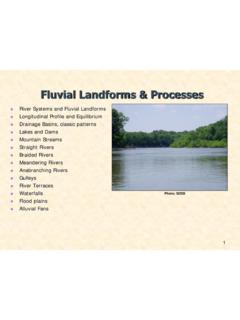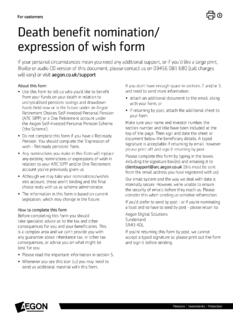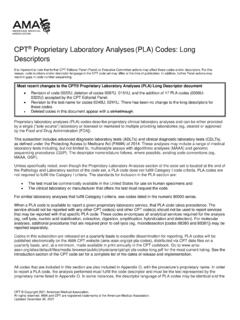Transcription of Folding/Faulting: Topographic Expression of Folded Strata
1 Folding/Faulting: Topographic Expression of Folded Strata Mountains: Orogenesis and Deformation Folding Faulting Joints & Fractures Domes and Basins Horst and Graben Rift Valleys US Examples: Sierra Nevada Grand Tetons (Rocky Mountains). Appalachian Mountains 1. Orogenesis Orogenesis is the thickening of the continental crust and the building of mountains over millions of years. Orogeny encompasses all aspects of mountain formation including plate tectonics, terrane accretion, regional metamorphism, thrusting, folding, faulting, and igneous intrusions. South Carolina's Blue Ridge Mountains and Inner Piedmont Region were formed by multiple orogenic events when rocks were uplifted, metamorphosed, Folded , faulted, and thrusted.
2 Photo courtesy of SCGS, SCDNR. 2. Deformation Deformation processes alter the earth's crust by extreme stress or pressure in the crust and mantle. Most deformation occurs along plate margins from plate tectonic movements. Folding and faulting are the most common deformation processes. Folding occurs when rocks are compressed such that the layers buckle and fold. Ductile deformation. Faulting occurs when rocks fracture under the accumulation of extreme stress created by compression and extensional forces. Brittle Deformation. Photo: South Carolina Geological Survey Photo: South Carolina Geological Survey 3. Deformation Structural Geology: the branch of geology that studies crustal deformation Notes: Folded Sandstone, Martin Bond/Science Photo Library/Photo Researchers, Inc.
3 Deformation Stress: the agent of change, units are pressure (force/area). Compression Tension Shearing Deformation Elastic deformation up to elastic limit Springs back to original shape Brittle failure (it breaks). Subjected to great stress that exceeds the elastic limit Subjected to sudden stress impact event . Plastic deformation Does not spring back keeps deformed shape High temperature near melting High pressure squeezed like a ball of clay The ratio of change produced in the dimensions of a body by a system of forces, in equilibrium, to its original dimensions is called strain. Strain = Change in Dimension/Original Dimension Factors Affecting Rock Deformation Intensity of applied stress Heat Temperature of the Rock Amount of Time the Stress is applied Rock Composition Folding 8.
4 Folding The crest of the fold, where the rock layers slope downward form the anticline. The valley of the fold where the layers slope toward the lower axis form the syncline. 9. Folding Anticlines and synclines can take on slightly different geometries depending on the compressional forces that form them. Very intense compressional forces form tight isoclinal folds, less intense compressional forces produce open folds. Folds can be asymmetric, upright, overturned, or curved. A fold pushed all the way over onto its side is called recumbent. 10. Fold Geometry 11. Folding: Scale Continuum Anticline exposed along NJ Route 23 near Syncline valley between Butler NJ.
5 Mountain peaks. Copyright Michael Lejeune Copyright USGS. Recumbent folds in limestone. Overturned folds in the Table Rock gneiss in South Carolina's piedmont. SCGS photo Copyright Marli Miller, University of Oregon 12. Folding Syncline (downfold) innermost rocks youngest Anticline (upfold) innermost rocks oldest Note: anticlines and synclines are structures in rocks, not surface landforms Anticlinal Ridge Synclinal Valley Folded Landforms: Influence of Denundation Plunging Folds Source: GEOPIC , Earth Satellite Corporation Domes and Basins Domes and basins are large, elongated folds formed by broad warping processes including mantle convection, isostatic adjustment, or swelling from a hot spot.
6 Domes contain Strata which increase in age toward the center as the younger layers are eroded from the top and sides. Basins contain Strata which is youngest toward the center and the oldest rocks form the flanks or sides. This geologic map of the Michigan Basin illustrates the circular pattern of the sedimentary Strata . The green color in the center of the map represents the youngest rocks which are Upper Pennsylvanian; and the rocks progressively increase in age toward the periphery where the reddish-orange colors represent the oldest rocks flanking this structure which are Ordovician and Cambrian age. Oldest Rocks (Ordivician and Cambrian).
7 Youngest rocks (Upper Pennsylvanian). 16. 3D-Folds Domes resemble anticlines, but the beds dip uniformly in all directions away from the center of the structure. Domes are caused by compression and uplift. Basins resemble synclines, but the beds dip uniformly in all directions toward the center of the structure. Basins are caused by compression and downwarping. 17. 3D-Folds Dome Formation: Impact Structures Refolding Diapirism: the process in which an igneous intrusion deforms the overlying more brittle rocks. The Richat Strurcture in the Sahara Desert of Mauritania. Long considered to be an impact structure, it is now believed by most to be a structural dome.
8 18. Faulting Faulting occurs when the rocks fail under deformation processes. A fault is a planar discontinuity along which displacement of the rocks occurs. Normal: rocks above the fault plane, or hanging wall, move down relative to the rocks below the fault plane, or footwall. Reverse: rocks above the hanging wall moves up relative to the footwall Strike-slip: rocks on either side of a nearly vertical fault plane move horizontally Oblique-slip: normal or reverse faults have some strike-slip movement, or when strike-slip faults have normal or reverse movement 19. Faulting 20. Fractures and Joints Joints occur where a rock breaks but there is no displacement or faulting associated with the break.
9 Joints are not singular features, but they occur in sets within a given type or area of a rock. Fractures are breaks in rocks that are often singular more random features and are not associated with a set of joints. Fractures often occur in association with faults or folds. Fractures and joints create a variety of pathways for water to flow through, which weaken the rock and facilitate chemical, biological, and mechanical weathering processes. 21. Fractures and Joints Common forms of jointing are columnar, sheet jointing, and tensional joints. Columnar jointing occurs when igneous rocks cool and develop shrinkage joints along pillar-like columns.
10 Sheeting joints occur when the layers of rock release pressure and exfoliate along parallel planes. Brittle fractures and tensional joints are caused by regionally extensive compressional or elongated pressures along folds in the crustal rocks. 22. Jointing The image below is of vertical jointed, bedded meta- sandstone in the Snake Range in Nevada. Copyright Bruce Molnia, USGS. Copyright Larry Fellows, Arizona Geological Survey These two images are an example of columnar jointing. The image on the top is a side view and the image below is from the top. These hexagonal columns of rock formed from cooled basalt are part of Devil's Postpile National Monument in California.







